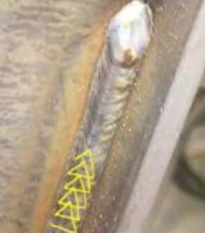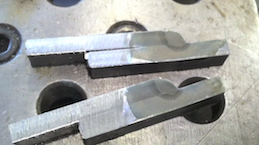Mig Welding Uphill
Mig welding flat and horizontal is pretty easy to learn.
Uphill is where things start to get hard.
While MIG is considered by many to be the easiest type of welding to learn.
learning to mig weld uphill can be a challenge.
Thin
sheet metal can be welded downhill which can be just as easy as welding
flat...but uphill? uphill is where gravity fights against you.But there are always different ways at looking at things.
Gravity is a factor. No doubt about that.
But gravity can actually work in your favor for migging thick steel.
Here is what I mean by that....
When
you mig weld downhill, gravity pulls the puddle downward so fast that
it is difficult to keep the arc on the leading edge of the puddle.
In fact, the puddle often runs ahead of the arc and actually can prevent the arc from penetrating in the base metal.
But
when you mig weld uphill, gravity keeps the puddle behind the arc and
allows the welder to manipulate the arc along the leading edge of the
puddle to get good and consistent penetration.
...a few tips that will let you mig weld uphill just as easily as downhill or flat.
- the charts inside most mig welders use settings that are hot and are intended for flat and horizontal fillet welds. Trying to use those same settings for vertical uphill wont work.
Instead, you need to pick the settings for thinner metal. For example, I was using a Hobart 210 mvp a few days ago and learned that settings for 1/8" steel worked great for vertical uphill on 1/4" steel.
Even though the settings are hot, the voltage and wire speed combinations work together. - use as short a stickout as possible. The stickout is the distance between the copper contact tip where the wire comes out...and the puddle. Keep it as short as possible without jamming the nozzle in the puddle.
- get a good ground. If your mig welder has a crappy ground, you are going to get crappy starts

A little bit of electrode manipulation goes a long way to help
flatten out the puddle. I like to trace the front of the puddle to make
sure the arc does its work and penetrates like it should
Downhill mig welding is limited in what it should be used for.
Downhill works fine on auto body panels, open butt root passes, fabricating racks out of 1/8" wall angle iron, robotic welds on automotive equipment or exercise equipment, and can even work on thick steel if the metal is perfectly clean and the procedure and welder are qualified.
But Downhill welding often does not penetrate thru hot rolled mill scale coatings and can often result in cold lap and lack of fusion.
For critical welds, in my
opinion, Anything over 3/16" thick should be welded uphill.
see more mig welding videos














